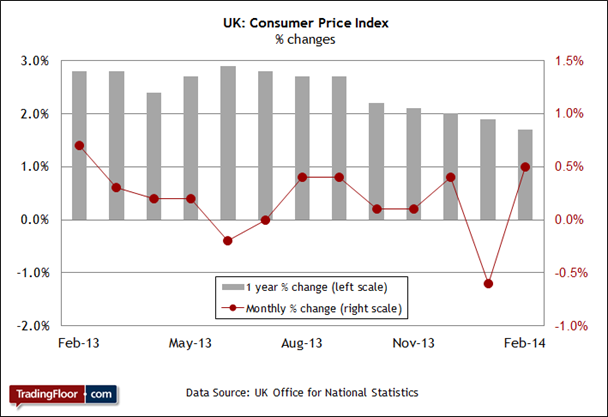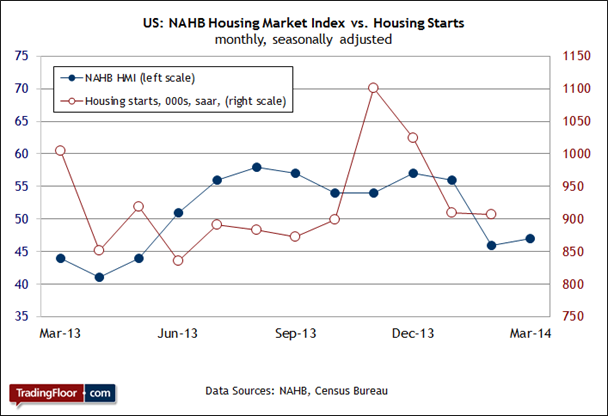• Fall in consumer inflation would bode well for UK economy
• ZEW German economic sentiment expected to dip
• US housing starts seen posting mild recovery
Tuesday is a moderately busy day for new numbers, including the monthly update on consumer price inflation in the UK. Later, we’ll see an update on economic sentiment in Germany based on new ZEW estimates. In addition, an update on the outlook for the US housing market arrives with the monthly report on the National Association of Home Builders/Wells Fargo Housing Market Index.Keep in mind that we'll also see new US inflation data (12.30 GMT) and hear from US Federal Reserve chairman Janet Yellen (14.45 GMT).
UK Consumer Price Index (08.30 GMT):
The recent decline in inflation is starting to deliver economic benefits to the British public. Economists believe that consumer inflation will ease to a 1.6 percent annual rate in today’s March update. The prediction inspires the view that the UK labour force will see real wages increase for the first time since 2010. In that case, the UK economy will have another positive trend in its corner.
"This week's data releases should confirm that wages are now rising faster than prices of goods and services, a Scotiabank economist in London said via The Guardian. “Previously, price increases were outpacing pay growth, meaning that households could afford to buy less and less with their pay cheques. The situation is now reversing and household purchasing power is on an improving trend," said Alan Clarke.
That bodes well for an already upbeat outlook for the economy. The UK is expected to expand 2.9 percent this year, based on the latest World Economic Outlook from the IMF. The estimate edges out the projected 2.8 percent rise for the US, and is well above the forecast of 1.7 percent for Germany. If today’s inflation news for Britain trickles down, confidence will improve a bit, for thinking that the UK growth outlook will meet or even exceed the IMF’s prediction.

Germany ZEW Economic Sentiment Index (09.00 GMT):
In line with expectations, industrial production in the Eurozone rose 0.2 percent in February, Eurostat reported yesterday. That’s good enough to keep the worst macro fears at bay for the moment but it’s still unconvincing for projecting that growth overall is set to accelerate. “A modest increase in industrial production in February supports [the] belief that Eurozone economic recovery is continuing to gradually firm,” noted Howard Archer, IHS Global Insight’s chief European economist. The numbers were a bit more encouraging on a year-over-year basis, with output rising 1.7 percent vs.the year-ago level, or a touch higher than January’s 1.6 percent rise.
Is the slightly better annual gain a sign that the tide is finally turning, if only moderately? As usual these days, when it comes to evaluating the macro prospects for the Eurozone, the analysis starts with Germany. The good news is that Europe’s biggest economy is continuing to expand at a healthy pace. Indeed, the year-over-year rate of growth in Germany’s industrial sector was 4 percent through February, or more than twice as fast as the rate for the Eurozone in general. Notably, industrial production in Germany is still far outpacing the rates in the other big economies in Europe on an annual basis. Yes, growth is still unbalanced, with an unhealthy reliance on Germany. That’s a problem but for now it’s still the only thing keeping the business cycle from turning ugly for the Continent.
As such, it’s a bit worrisome to learn that economic expectations are falling among German institutional investors, according to ZEW data. The forward-looking benchmark in the March update fell to its lowest level since last August, and the consensus forecast is seeing another mild dip in today’s update. It’s probably just noise although the soft data is a reminder that you still can’t take the forecast of a Eurozone recovery for granted. If there’s more risk lurking than the latest industrial production report for Europe implies, we’ll catch an early warning by way of macro expectations that suffer more than a slight drop in today’s ZEW release.
US NAHB Home Builders Index (14.00 GMT):
US economic data for March is continuing to show a rebound after a harsh winter took a bite out of the growth rate. Yesterday’s retail sales report, for instance, reflected a strong revival in consumer spending. In fact, last month’s macro profile looks encouraging generally, based on the available updates so far. The weak spot is housing and so today’s news on sentiment in the home building industry will provide an early clue for where this key corner of the economy is headed for the rest of 2014.
For the moment, the data is mixed. Housing starts, for instance, have slumped this year after posting an impressive revival in late-2013. The recent decline in builder confidence suggests we won’t see much improvement, at least not in the near term. For the first time since last May, more builders have a negative outlook on the sector, according to the February and March readings of the National Association of Home Builders/Wells Fargo Housing Market Index (HMI). “The March HMI mirrors last month’s sentiment, as builders continued to be affected by poor weather and difficulties in finding lots and labour,” said NAHB’s chairman in a press release last month.
Nonetheless, economists believe we’ll see a modest improvement in today’s April number as HMI inches back towards the neutral 50 mark. That alone doesn’t mean much but a rise in today’s estimate will look promising when you factor in the rebound in a range of economic data from elsewhere in the economy. Indeed, if the broad macro trend is improving, as it seems to be, housing will probably follow.

